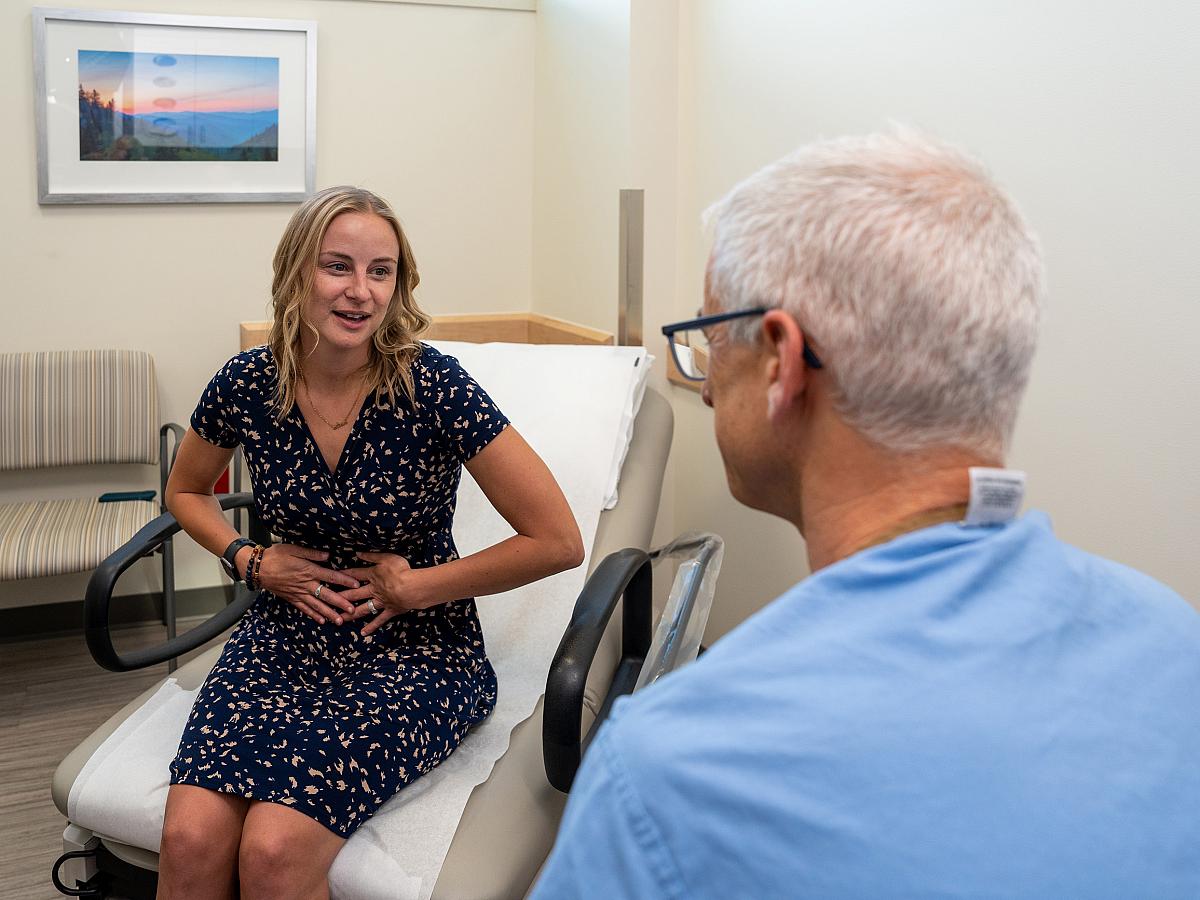What Is Vaginitis?
Vaginitis occurs when your vagina, or birth canal, is inflamed or irritated. Vaginitis causes itching, discharge, pain, and sometimes odor. It’s frequently caused by bacteria, yeast infections, and sexually transmitted infections (STIs).
Vaginosis vs. Vaginitis
Vaginitis is a broad term that means either your vulva or vagina is inflamed. Your vulva is the opening of the vagina and includes the labia (two sets of skin folds) and the clitoris. Vaginosis is a type of vaginitis that occurs when you have an imbalance of “good” and “bad” bacteria in your vagina. It usually does not cause inflammation.
Vaginitis and vaginosis usually aren’t serious, but it’s a good idea to see a health care provider to rule out STIs (sexually transmitted infections) and prevent complications. At University of Utah Health, our Women’s Health Services providers offer expert treatment for vaginitis. We will find the cause of your vaginitis and recommend treatment strategies.
Vaginitis Causes
The most common cause of vaginitis is an overgrowth of bacteria that upsets the vagina’s natural balance. Sexual activity and frequent douching can affect this balance.
Other vaginitis causes include:
- allergies to vaginal sprays, douches, latex condoms, or spermicides;
- decreased estrogen levels due to hysterectomy, menopause, or ovary damage;
- sensitivity to perfumed soaps, scented hygiene products, and laundry detergents;
- sexual intercourse and sex toys; and
- sexually transmitted infections, such as trichomoniasis,
- viruses, such as herpes or the human papillomavirus, and
- yeast infections.
Acute Vaginitis
Acute vaginitis refers to any inflammation of the vagina or vulva. A disturbance to your vagina can cause irritation and inflammation. Symptoms may go away on their own, or you may need treatment for vaginitis from your health care provider.
Acute vaginitis is common. One-third of women experience vaginitis at some point in their lives. Chronic vaginitis, though rare, occurs when you have symptoms three times or more a year.
Atrophic Vaginitis
Atrophic vaginitis occurs during menopause or perimenopause (before menopause). It’s also called genitourinary syndrome of menopause (GSM). A decrease in the estrogen hormone causes your vaginal walls and bladder to thin, leading to vaginitis symptoms.
GSM can mimic a urinary tract infection, causing burning during urination and a need to urinate often and urgently.
Bacterial Vaginosis
An overgrowth of harmful bacteria in your vagina causes bacterial vaginosis. Frequent douching, using an intrauterine device (IUD) for birth control, and sexual intercourse with multiple partners may cause bacterial vaginitis.
Your doctor may prescribe antibiotics to restore the normal pH balance of your vagina.
Vaginitis Symptoms
Symptoms of vaginitis vary, depending on the cause of your vaginal irritation. In general, vaginitis symptoms include:
- a change in the color, odor, or volume of your vaginal discharge,
- abdominal pain,
- discolored or swollen vulva,
- discomfort during sex,
- itching, burning, or pain in your vagina or vulva,
- light vaginal bleeding or spotting, and
- painful urination.
Vaginitis symptoms may be obvious, or you may have no symptoms. Be aware of how your vulva and vaginal discharge typically looks, feels, and smells. This awareness will help you identify abnormal symptoms and signs of vaginitis.
What Does Vulvovaginitis Look Like?
With vulvovaginitis, your labia and the area around your vaginal opening may look swollen and inflamed. With atrophic vaginitis, your vulva may look colorless and dry.
Vulvovaginitis Sores
Vulvovaginitis can cause bumps or sores on your vulva. They may look like a rash or appear to be a break in your skin. STIs and yeast infections can also cause sores on your vulva.
Vaginitis Rash
Yeast and bacteria can cause a rash on your vulva. The rash may be itchy and cause pain during urination and sex.
Vaginitis Discharge
The cause of vaginitis determines the color, consistency, and odor of vaginal discharge. For example, you may experience:
- cottage-cheese-looking discharge is usually a yeast infection,
- frothy, greenish-yellow discharge indicates trichomoniasis, and
- gray or white discharge that may smell like fish is bacterial vaginitis.
Is Vaginitis Contagious?
Vaginitis can be contagious, especially when caused by trichomoniasis or another STI.
Sexual partners can also pass yeast infections during vaginal, anal, or oral sex. The risk of infection is low for a male who has unprotected intercourse with a woman who has a yeast infection. However, a risk of infection is greater between two female partners.
How to Test for Vaginitis
A health care provider will test for vaginitis using these steps:
- review your medical history, including vaginal infections or STIs,
- perform a pelvic exam using an instrument called a speculum to look inside your vagina,
- collect a sample of your vaginal discharge for testing in a lab, and
- measure the pH levels in your vagina by placing a special paper on its wall.
Vaginitis Treatment
Treating vaginitis depends on the underlying cause. Antifungal and antibacterial medications treat vaginitis. After determining the cause of your vaginal irritation, your health care provider will recommend appropriate medication.
Your health care provider may treat bacterial vaginitis with oral prescription medications or with gels and creams placed inside your vagina or on your vulva.
Home Remedies for Vaginitis
Home remedies for vaginitis may prevent or reduce symptoms.
- Apply petroleum jelly or coconut oil to the irritated skin on your vulva.
- Avoid feminine washes, powders, and douches that irritate the vagina and vulva. Use mild, unscented soaps for cleansing.
- Boric acid suppositories can help maintain a healthy pH balance in your vagina. These capsules are available over the counter and should be placed directly in the vagina. However, they are toxic if taken orally.
- Relieve discomfort in a sitz bath. Soak your vulva in warm water. You can use your bathtub or buy an attachment for your toilet.
- Change your soap, detergent, or tampons if an allergy or sensitivity cause your vaginitis.
How Long Does Vaginitis Last?
With treatment, acute vaginitis should go away within two weeks. Long-term or recurrent vaginitis may last for three to six months.
Does Vaginitis Go Away on Its Own?
Vaginitis can go away on its own. However, adopting a wait-and-see approach is not a good idea unless you know what’s causing your vaginitis. You should get screened for STIs, especially if you’ve had new or multiple sexual partners in the days or weeks before symptoms began.
How to Prevent Vaginitis
You can decrease your chance of getting vaginitis in the following ways.
Ask your health care provider about hormone replacement therapy if you’re approaching menopause or have had your ovaries removed.
- Avoid tight-fitting clothes that retain heat and moisture. Instead, wear loose, breathable fabrics like cotton.
- Change out of wet bathing suits or workout clothes quickly. Yeast and bacteria thrive in warm, moist environments.
- Don’t clean your vagina with perfumed soaps or sprays.
- Don’t douche, as it disturbs the healthy balance of bacteria in your vagina.
- Practice safe sex by using condoms and dental dams.
Can You Have Sex with Vaginitis?
Inflammation in your vulva and vagina may make having sex with vaginitis uncomfortable. Additionally, to avoid spreading STIs, it’s not a good idea to have sex until you’ve been seen by a provider and determined what’s causing your discomfort.
Why Choose U of U Health?
At U of U Health, our Women’s Health Services providers see patients with acute and recurrent vaginitis. If you’ve had multiple infections within six months, it’s essential to be seen by providers with expertise in treating this complex condition.
Additionally, our Midlife Women’s Health and Menopause Program helps women experiencing atrophic vaginitis. Many of our midlife women’s health care providers are NAMS (North American Menopause Society) Certified Menopause Practitioners (NCMP), committed to helping you maintain your quality of life, now and in the years ahead.
Make an Appointment
To make an appointment with a Women’s Health Services provider, please call 801-213 2995.






